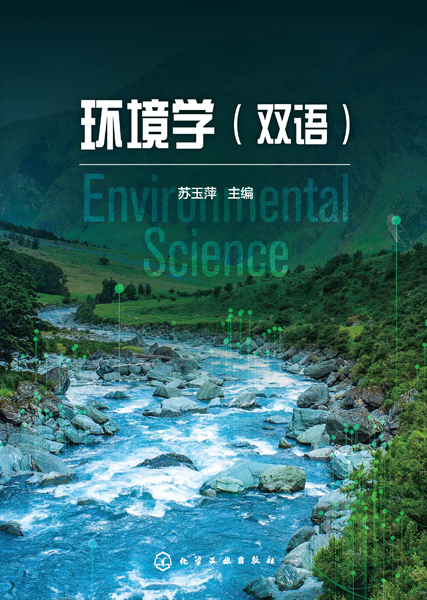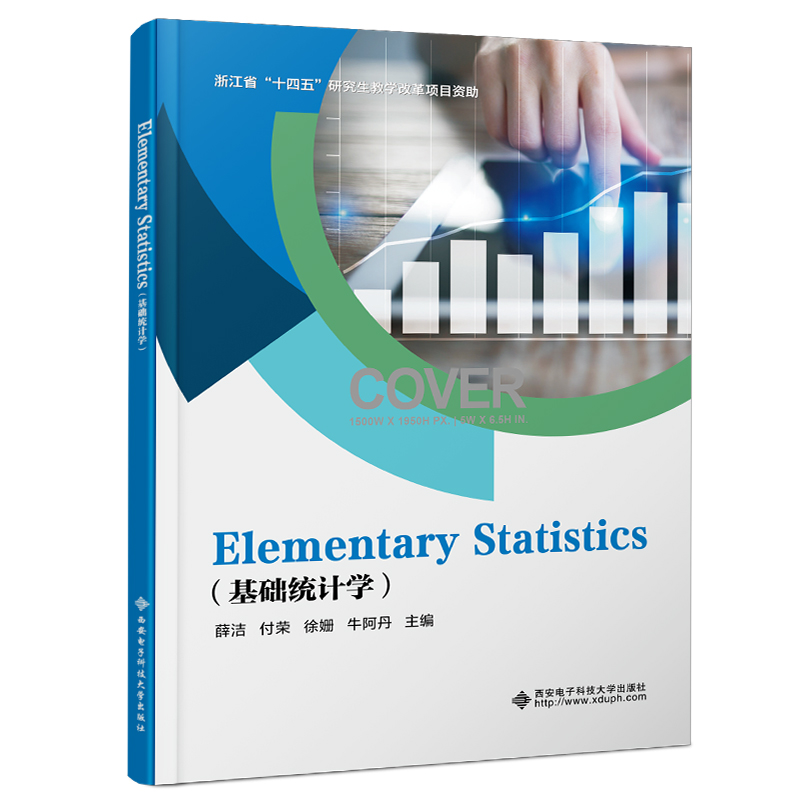环境学(双语)
定价:¥68.00
作者: 苏玉萍
出版时间:2020-11
最新印次日期:2023-1
出版社:化学工业出版社
- 化学工业出版社
- 9787122370358
- 1版
- 347221
- 60262846-3
- 平膜
- 16开
- 2020-11
- 487
- 297
- 工学
- 环境科学与工程类
- ①X
- 环境类
- 本科
作者简介
内容简介
本书共十二章,内容包括绪论,科学与科学研究方法,生态与环境,人口与环境,能源与环境,水资源与水环境,大气环境,土壤环境,固体废物与物理性污染,环境经济,环境政策,环境伦理与可持续发展。本书重点内容配有中文翻译,每章配有中文小结,可作为高等学校环境类专业教材使用,也可供从事生态环保工作的科研人员参考。
目录
Chapter 1 Introduction1
1.1Definition of Environment1
1.1.1Fundamental Concept of Environment1
1.1.2Population Growth and Economic Development3
1.1.3Environment and Globalization5
1.2Environmental Issues7
1.2.1Resource Depletion7
1.2.2Pollution11
1.2.3Climate Change13
1.3The Nature of Environmental Science15
1.3.1The Development of Environmental Science15
1.3.2Two Core Concepts16
1.3.3An Ecosystem Approach19
Summary19
Review Questions20
References21
Chapter 2 Science and Scientific Research Methods23
2.1Scientific Thinking23
2.1.1Scientific Method23
2.1.2Inductive and Deductive Reasoning27
2.2Important Scientific Laws and Theories29
2.2.1Matter and Energy29
2.2.2First Law of Thermodynamics32
2.2.3Second Law of Thermodynamics32
2.2.4The Law of Conservation of Matter34
2.3Systems & Systems Analysis35
2.3.1Systems35
2.3.2Systems Analysis37
2.3.3Positive Feedback and Negative Feedback38
Summary39
Review Questions40
References40
Chapter 3 Ecology and Environment42
3.1Characteristics of Ecosystem43
3.1.1Ecosystem43
3.1.2The Composition of Ecosystem44
3.1.3The Structure of Ecosystem45
3.2The Functions of Ecosystem47
3.2.1The Production of Ecosystem47
3.2.2Matter Cycle in Ecosystem48
3.2.3Energy Flowing52
3.2.4Information Transfer52
3.2.5Ecosystem Balance53
3.3Biodiversity Conservation and Ecological Restoration53
3.3.1The Value of Biodiversity53
3.3.2The Loss of Biodiversity55
3.3.3Conservation Strategies55
3.4Ecological Restoration56
3.5Urban Ecosystem57
Summary58
Review Questions59
References59
Chapter 4 Human Population and Environment61
4.1Population Growth and Environmental Capacity61
4.1.1Population and Population Growth61
4.1.2Population Carrying Capacity65
4.2Food Production68
4.2.1Food Security68
4.2.2Environmental Issues in Food Production72
4.3Balance of Population,Food and Environment72
4.3.1Genetic Engineering73
4.3.2Pest Control75
4.3.3Sustainable Agriculture77
Summary80
Review Questions81
References81
Chapter 5 Energy83
5.1Nonrenewable Resource83
5.1.1Coal83
5.1.2Oil86
5.1.3Natural Gas89
5.1.4Nuclear Energy90
5.2Renewable Energy92
5.2.1Solar Energy92
5.2.2Wind Power94
5.2.3Bioenergy95
5.2.4Hydropower97
5.2.5Other Renewable Energy98
5.3Energy Efficiency100
5.3.1Current Situation of Energy Efficiency100
5.3.2Ways to Improve Energy Efficiency101
Summary105
Review Questions106
References106
Chapter 6 Water Resources and Environment108
6.1World Water Resources108
6.1.1The Distribution Features of Water Resources108
6.1.2The Characteristics of Water110
6.1.3The Water Cycle111
6.2Floods and Droughts112
6.2.1Floods112
6.2.2Droughts115
6.3The Prevention of Water Pollution117
6.3.1Definition and Classification of Water Pollution117
6.3.2Sources of Water Pollution117
6.3.3Damages of Water Pollutions118
6.3.4Prevention and Treatment of Surface Water Pollution126
Summary127
Review Questions127
References128
Chapter 7 Atmospheric Environment132
7.1The Atmosphere132
7.1.1Atmospheric Composition132
7.1.2Atmospheric Properties134
7.1.3Atmospheric Structure135
7.1.4Wind138
7.1.5Temperature Inversions138
7.2Atmospheric Pollutants139
7.2.1Sources and Types of Air Pollutants139
7.2.2Critical Pollutants141
7.3Atmospheric Pollution143
7.3.1Outdoor Air Pollution144
7.3.2Indoor Air Pollution149
7.4Control of Air Pollution152
7.4.1China’s Five-Year Plans153
7.4.2How to Reduce Outdoor Air Pollution154
7.4.3How to Reduce Indoor Air Pollution156
Summary158
Review Questions159
References160
Chapter 8 Soil and Environment162
8.1Soil Overview162
8.1.1Soil Formation163
8.1.2Soil Properties164
8.2Soil Degradation169
8.2.1Concept of Soil Degradation169
8.2.2Soil Erosion170
8.2.3Types of Soil Degradation174
8.3Soil Pollution178
8.3.1Concept of Soil Pollution179
8.3.2Mechanism of Soil Pollution180
8.3.3Effects of Soil Pollution181
Summary185
Review Questions186
References186
Chapter 9 Solid Waste and Physical Contamination188
9.1Solid Waste188
9.1.1Classification of Solid Waste188
9.1.2Harm of Solid Waste191
9.1.3Solid Waste Management196
9.1.4Disposals of Solid Waste198
9.2Physical Contamination206
9.2.1Noise Pollution206
9.2.2Electromagnetic Radiation207
9.2.3Radioactive Contamination208
9.2.4Thermal Pollution210
Summary211
Review Questions211
References212
Chapter 10 Environment and Economy213
10.1Environmental Economy213
10.1.1Concept of Environmental Economy213
10.1.2Circular Economy214
10.1.3Economy and Sustainable Development216
10.2Basic Economic Content217
10.2.1Resources218
10.2.2Economic and Ecological Systems220
10.2.3Environment Accounting222
10.3Environmental Economic Measures223
10.3.1Externality223
10.3.2Pigovian Taxes226
10.3.3Coase Theorem227
10.4Environmental Economic Analysis229
10.4.1Environment Costs229
10.4.2Cost-benefit Analysis231
Summary233
Review Questions235
References236
Chapter 11 Environmental Policy238
11.1Environmental Policy and Environmental Protection238
11.1.1Environmental Policy238
11.1.2Principles of Environmental Policy239
11.1.3The Rationale of Environmental Policy240
11.2Global Environmental Policy242
11.2.1Environmental Policy in the United States243
11.2.2Environmental Policy in China244
11.2.3Environmental Policy in the European Union249
11.2.4International Environmental Policy250
11.3Chinese Environmental Policy Cases252
11.3.1Environmental Impact Assessment252
11.3.2The Environmental Finance Policies in China254
11.4Environmental Education and Public Participation258
11.4.1Environmental Education258
11.4.2Public Participation261
Summary264
Review Questions265
References265
Chapter 12 Environmental Ethics and Sustainable Development267
12.1Environmental Ethics267
12.1.1Development of Environmental Ethics268
12.1.2Research of Environmental Ethics269
12.2The Main Types of Environmental Ethics271
12.2.1Anthropocentrism271
12.2.2Biocentrism271
12.2.3Ecocentrism273
12.2.4Others274
12.3Environmental Attitudes278
12.3.1Development278
12.3.2Preservation278
12.3.3Conservation278
12.3.4Sustainable Development279
12.4Sustainable Development and Exploration279
12.4.1Concept of Sustainable Development280
12.4.2Exploration of Sustainable Development285
12.4.3Living More Sustainably290
12.5For Better Future291
Summary295
Review Questions296
References296
1.1Definition of Environment1
1.1.1Fundamental Concept of Environment1
1.1.2Population Growth and Economic Development3
1.1.3Environment and Globalization5
1.2Environmental Issues7
1.2.1Resource Depletion7
1.2.2Pollution11
1.2.3Climate Change13
1.3The Nature of Environmental Science15
1.3.1The Development of Environmental Science15
1.3.2Two Core Concepts16
1.3.3An Ecosystem Approach19
Summary19
Review Questions20
References21
Chapter 2 Science and Scientific Research Methods23
2.1Scientific Thinking23
2.1.1Scientific Method23
2.1.2Inductive and Deductive Reasoning27
2.2Important Scientific Laws and Theories29
2.2.1Matter and Energy29
2.2.2First Law of Thermodynamics32
2.2.3Second Law of Thermodynamics32
2.2.4The Law of Conservation of Matter34
2.3Systems & Systems Analysis35
2.3.1Systems35
2.3.2Systems Analysis37
2.3.3Positive Feedback and Negative Feedback38
Summary39
Review Questions40
References40
Chapter 3 Ecology and Environment42
3.1Characteristics of Ecosystem43
3.1.1Ecosystem43
3.1.2The Composition of Ecosystem44
3.1.3The Structure of Ecosystem45
3.2The Functions of Ecosystem47
3.2.1The Production of Ecosystem47
3.2.2Matter Cycle in Ecosystem48
3.2.3Energy Flowing52
3.2.4Information Transfer52
3.2.5Ecosystem Balance53
3.3Biodiversity Conservation and Ecological Restoration53
3.3.1The Value of Biodiversity53
3.3.2The Loss of Biodiversity55
3.3.3Conservation Strategies55
3.4Ecological Restoration56
3.5Urban Ecosystem57
Summary58
Review Questions59
References59
Chapter 4 Human Population and Environment61
4.1Population Growth and Environmental Capacity61
4.1.1Population and Population Growth61
4.1.2Population Carrying Capacity65
4.2Food Production68
4.2.1Food Security68
4.2.2Environmental Issues in Food Production72
4.3Balance of Population,Food and Environment72
4.3.1Genetic Engineering73
4.3.2Pest Control75
4.3.3Sustainable Agriculture77
Summary80
Review Questions81
References81
Chapter 5 Energy83
5.1Nonrenewable Resource83
5.1.1Coal83
5.1.2Oil86
5.1.3Natural Gas89
5.1.4Nuclear Energy90
5.2Renewable Energy92
5.2.1Solar Energy92
5.2.2Wind Power94
5.2.3Bioenergy95
5.2.4Hydropower97
5.2.5Other Renewable Energy98
5.3Energy Efficiency100
5.3.1Current Situation of Energy Efficiency100
5.3.2Ways to Improve Energy Efficiency101
Summary105
Review Questions106
References106
Chapter 6 Water Resources and Environment108
6.1World Water Resources108
6.1.1The Distribution Features of Water Resources108
6.1.2The Characteristics of Water110
6.1.3The Water Cycle111
6.2Floods and Droughts112
6.2.1Floods112
6.2.2Droughts115
6.3The Prevention of Water Pollution117
6.3.1Definition and Classification of Water Pollution117
6.3.2Sources of Water Pollution117
6.3.3Damages of Water Pollutions118
6.3.4Prevention and Treatment of Surface Water Pollution126
Summary127
Review Questions127
References128
Chapter 7 Atmospheric Environment132
7.1The Atmosphere132
7.1.1Atmospheric Composition132
7.1.2Atmospheric Properties134
7.1.3Atmospheric Structure135
7.1.4Wind138
7.1.5Temperature Inversions138
7.2Atmospheric Pollutants139
7.2.1Sources and Types of Air Pollutants139
7.2.2Critical Pollutants141
7.3Atmospheric Pollution143
7.3.1Outdoor Air Pollution144
7.3.2Indoor Air Pollution149
7.4Control of Air Pollution152
7.4.1China’s Five-Year Plans153
7.4.2How to Reduce Outdoor Air Pollution154
7.4.3How to Reduce Indoor Air Pollution156
Summary158
Review Questions159
References160
Chapter 8 Soil and Environment162
8.1Soil Overview162
8.1.1Soil Formation163
8.1.2Soil Properties164
8.2Soil Degradation169
8.2.1Concept of Soil Degradation169
8.2.2Soil Erosion170
8.2.3Types of Soil Degradation174
8.3Soil Pollution178
8.3.1Concept of Soil Pollution179
8.3.2Mechanism of Soil Pollution180
8.3.3Effects of Soil Pollution181
Summary185
Review Questions186
References186
Chapter 9 Solid Waste and Physical Contamination188
9.1Solid Waste188
9.1.1Classification of Solid Waste188
9.1.2Harm of Solid Waste191
9.1.3Solid Waste Management196
9.1.4Disposals of Solid Waste198
9.2Physical Contamination206
9.2.1Noise Pollution206
9.2.2Electromagnetic Radiation207
9.2.3Radioactive Contamination208
9.2.4Thermal Pollution210
Summary211
Review Questions211
References212
Chapter 10 Environment and Economy213
10.1Environmental Economy213
10.1.1Concept of Environmental Economy213
10.1.2Circular Economy214
10.1.3Economy and Sustainable Development216
10.2Basic Economic Content217
10.2.1Resources218
10.2.2Economic and Ecological Systems220
10.2.3Environment Accounting222
10.3Environmental Economic Measures223
10.3.1Externality223
10.3.2Pigovian Taxes226
10.3.3Coase Theorem227
10.4Environmental Economic Analysis229
10.4.1Environment Costs229
10.4.2Cost-benefit Analysis231
Summary233
Review Questions235
References236
Chapter 11 Environmental Policy238
11.1Environmental Policy and Environmental Protection238
11.1.1Environmental Policy238
11.1.2Principles of Environmental Policy239
11.1.3The Rationale of Environmental Policy240
11.2Global Environmental Policy242
11.2.1Environmental Policy in the United States243
11.2.2Environmental Policy in China244
11.2.3Environmental Policy in the European Union249
11.2.4International Environmental Policy250
11.3Chinese Environmental Policy Cases252
11.3.1Environmental Impact Assessment252
11.3.2The Environmental Finance Policies in China254
11.4Environmental Education and Public Participation258
11.4.1Environmental Education258
11.4.2Public Participation261
Summary264
Review Questions265
References265
Chapter 12 Environmental Ethics and Sustainable Development267
12.1Environmental Ethics267
12.1.1Development of Environmental Ethics268
12.1.2Research of Environmental Ethics269
12.2The Main Types of Environmental Ethics271
12.2.1Anthropocentrism271
12.2.2Biocentrism271
12.2.3Ecocentrism273
12.2.4Others274
12.3Environmental Attitudes278
12.3.1Development278
12.3.2Preservation278
12.3.3Conservation278
12.3.4Sustainable Development279
12.4Sustainable Development and Exploration279
12.4.1Concept of Sustainable Development280
12.4.2Exploration of Sustainable Development285
12.4.3Living More Sustainably290
12.5For Better Future291
Summary295
Review Questions296
References296










